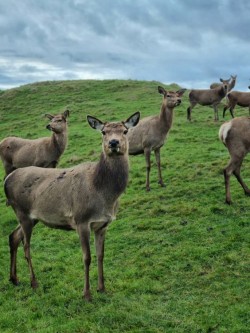Oct 19, 2023
The future for New Zealand venison involves a series of individual value chains with groups of farmers supplying animals targeting different niches, DINZ board member and First Light group managing director Gerard Hickey predicts.

Hinds are ready to go into their fawning paddocks. Photo: Jennifer Jopson.
Hickey outlined the latest outlook for venison in his presentation to NZDFA branch chairs, repeating messages delivered at the recent DINZ South Island road trip, and showing how venison marketers’ efforts to diversify markets are paying off.
Strong demand for chilled venison has seen processors paying up to $10.50 per kg for product that will go into the high-value premium market, which is a good start to the season.
“Margins are being made by processors as well. Importers are relatively happy – except they can’t get enough product,” he said.
The frozen venison market in Europe, however, is “not so flash and that’s why we can’t be reliant on it,” he told the leaders.
This further underscores the importance of efforts to move away from the commodity market, pivoting to US retail and emerging markets elsewhere, which the venison marketers agree is the best way to lift producer returns. At the end of 2022, exporters had shipped 14 percent less volume on the year before to the region, with shipments now accounting for 44 percent of the total.

DINZ deputy chair Gerard Hickey.
As the deer industry gets smaller and diversification progresses, it will become more “positively fragmented”, he believes. Hickey sees reduced reliance on the published national schedule, which largely covers product supplied for the commodity market.
What will emerge are individual value chains of smaller groups of farmers supplying customers who want a “certain parcel of venison”, say around 15,000 animals “to be economical,” for market niches that will “pay higher prices than the schedule.”
Hickey is “excited by what is happening in USA”, not only at retail, but foodservice too. US retail takes chilled, fresh, trim and leg-based products on a year-round basis, with strong and stable pricing.
Focusing on US retail has already lifted that market’s share of New Zealand venison to 32 percent in 2022, up eight percent on the previous year, his pie-chart showed.
Additional Sustainable Food & Fibre Futures (SFFF) funding had been sought from the Ministry for Primary Industries, which will be matched in thirds by DINZ and the companies for a concentrated $5 million programme in that market over the next three years. This investment will enable all five venison companies to develop their own products and brands, with DINZ coordinating support for the companies’ activities at trade shows, in-store promotions, public relations and social media, market research and so on.
First Light, for example, might, “pick 700 supermarkets on the West Coast, and maybe into Texas, and launch our products. We’ve got some ideas about new leg products,” he said.
NZDFA Hawke’s Bay branch chair Evan Potter and others were looking for an indication of a return on their levy investment, through DINZ.
Sales targets had been included in the SFFF application. Collectively, the companies aim to lift retail sales of manufacturing-type cuts to 1,800 tonnes a year and for sales of new retail items from leg cuts to hit 300 tonnes a year by year three of the programme, Griffiths noted.
One of the new niches being explored by the marketers is demand for elk, with which American consumers are familiar. Some companies have a long history of supplying New Zealand Elk to their North American customers and others are developing new programmes to meet specific customer requirements. First Light, Mountain River Venison and Alliance, recently launched their own new elk products.
China, already accounting for 24 percent of exports – and up six percent on the previous year – also provides “real valuable diversification,” said Hickey. Some DINZ funding has been made available to support marketing activity in the market.
Co-products and edible offal are other valuable products lifting overall returns from venison carcases. Co-products including hides, offal, sinews, pizzles and tendons can add $100 to a carcase, Hickey noted. Alliance makes sure labour resources are available for the valuable venison co-products, “to ensure that we don’t drop anything that is too valuable,” assured Alliance general manager strategy and DINZ board member Nigel Jones.
Among the other valuable high-returning niches being explored by marketers for New Zealand venison are Scandinavia and the Middle East.

